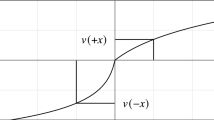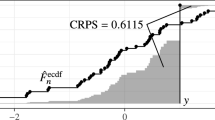Summary
The Multinomial Logit (MNL) model is still the only viable option to study nonlinear responsiveness of utility to covariates nonparametrically. This research investigates whether MNL structure of inter-brand competition is a reasonable assumption, so that when the utility function is estimated nonparametrically, the IIA assumption does not bias the result. For this purpose, the authors compare the performance of two comparable nonparametric choice models that differ in one aspect: one assumes MNL competitive structure and the other infers the pattern of brands’ competition nonparametrically from data.






Similar content being viewed by others
Notes
1 In fact from this very reason, for example, Rossi, McCulloch, and Allenby (1996) limit the estimation to only the diagonal elements of the variance-covariance matrix for the stochastic component instead of all elements including those in off-diagonal.
2Nonparametric MNL recovers the maximum at 0.5 and minimum at 0.75 for the quadratic functions of Xl and Xp, respectively, in vj quite well. Each small dot on the graph corresponds to a single choice occasion.
3In nonparametric logistic regression, because η = v1 - v2, the effect of Xl1 and Xp1 and that of Xl2 and Xp2 have opposite signs. The maximum at 0.5 and minimum at 0.75 for Xl1 and Xp1 and the minimum at 0.5 and maximum at 0.75 for Xl2 and Xp2 in η are recovered quite well.
4Because nonparametric MNL presumes IIA, the estimation for the quadratic functions of Xl and Xp for vj is quite poor.
5Nonparametric logistic regression recovers the maximum at 0.5 and minimum at 0.75 for Xl1 and Xp1 and the fiat response for Xl2 and Xp2 in η quite well.
6The loyalty variable must be initialized (Guadagni and Little 1983). This was done using the sample prior to the dataset we used for model calibration.
7The degrees of freedom is directly related to the value of the smoothing constant for the kernel estimator adopted here in the nonparametric regression. We have conducted a grid search on the smoothing constant in our simulation study to determine this value of 3.9, which achieved a good balance of the trade off between calibration fit and predictive performance. For calculation of degrees of freedom for nonparametric models, please see Hastie and Tibshirani 1990, ch. 4.
9η for brand 1 choice increases with LOYALTY1 and decreases but not monotonically with LOYALTY2. η for brand 1 choice decreases with PRICE1 and increases with PRICE2 and PRICE3, which is intuitive. However, the data points in figures for PRICE2 and PRICE3 are rather sparse to allow their accurate nonparametric estimation.
8Support for the near linearity in eovariates is obtained by estimating a parametric counterpart, a standard linear-in-parameters MNL model. The loglikelihood value decreases by a small amount from −1910.98 for the semiparametric specification to −1917.38 for the linear parametric one. The linearity in covariates cannot be rejected by the likelihood ratio test (χ2 = 12.8 for 5.8 degrees of freedom).
10Utility increases with LOYALTY in a slightly nonlinear fashion and decreased linearly with PRICE. The observation points seem dense enough to warrant a sufficiently accurate nonparametric estimation.
11In the simulation, the logistic regression has four nonparametric functions corresponding to Xl1, Xl2, Xpl, Xp2 for each brand choice, whereas MNL had Xl and Xp for both brands. In the actual data, the numbers were 15 for logistic regression versus 2 for MNL.
12If MNL has K nonparametric functions, logistic regression has J × K functions for each of the J brands, thereby the factor of J2. In the actual data of J = 3, the factor was 7.5 rather than 9 because only J - 1 instead of J loyalty variables existed due to dependency across brands.
References
Abe, M. (1995), ‘A nonparametric density estimation method for brand choice using scanner data’,Marketing Science 14(3), 300–325.
Abe, M. (1998), ‘Measuring consumer, nonlinear brand choice response to price’,Journal of Retailing 74(4), 541–568.
Abe, M. (1999), ‘A generalized additive model for discrete-choice data’,Journal of Business & Economic Statistics 17(3), 271–284.
Ben-Akiva, M. and Lerman, S. (1985),Discrete Choice Analysis: Theory and Application to Travel Demand, MIT Press, Cambridge, MA.
Boztuğ, Y. and Hildebrandt, L. (2001), ‘Nichtparametrische Methoden zur Schätzung von Responsefunktionen’,in H. Hippner, U. Küsters, M. Meyer and K. Wilde, eds, ‘Handbuch Data Mining im Marketing’, Vieweg, pp. 241–251.
Briesch, R. A., Chintagunta, P. K. and Matzkin, R. L. (1997), Nonparametric and semiparametric models of brand choice behavior, Technical report, University of Texas at Austin.
Gonul, F. and Srinivasan, K. (1993), ‘Modeling Multiple Sources of Heterogeneity in Multinomial Logit Models: Methodological and Managerial Issues’,Marketing Science,12(3), 213–229.
Guadagni, P. M. and Little, J. D. C. (1983), ‘A logit model of brand choice calibrated on scanner data’,Marketing Science 2(3), 203–238.
Härdie, W., Klinke, S. and Müller, M. (2000),XploRe Learning Guide, Springer-Verlag, Berlin.
Hastie, T. J. and Tibshirani, R. J. (1986), ‘Generalized additive models’,Statistical Science 1(3), 297–318.
Hastie, T. J. and Tibshirani, R. J. (1987), ‘Generalized additive models: Some applications’,Journal of the American Statistical Association 82(398), 371–386.
Hastie, T. J. and Tibshirani, R. J. (1990),Generalized Additive Models, Chapman & Hall, London.
Hausman, J. and McFadden, D. (1984), ‘A Specification Test for the Multinomial Logit Model’,Econometrica 52, 1219–1240.
Hruschka, H., Probst, M. and Fettes, W. (2001), Homogeneous and Latent Class Versions of the Neural Net-Multinomial Logit Model (NN-MNL): A Semiparametric Approach to Analyze Brand Choice, Discussion Paper 363, Faculty of Economics, University of Regensburg.
Kamakura, W. A. and Russell, G. J. (1989), ‘A Probabilistic Choice Model for Market Segmentation and Elasticity Structure’,Journal of Marketing Research,26(4), 379–390.
Manski, C. F. and McFadden, D. (1981), Alternative estimators and sample designs for discrete choice analysis,in C. F. Manski and D. McFadden, eds, ‘Structural Analysis of Discrete Data with Econometric Applications’, The MIT Press, pp. 2–50.
McCulloch, R. E. and Rossi, P. E. (1994), ‘An Exact Likelihood Analysis of the Multinomial Probit Model’,Journal of Econometrics,64, 207–240.
McFadden, D. (1974), ‘Conditional Logit Analysis of Qualitative Choice Behavior’,in P. Zarembka, ed, ‘Frontiers in Econometrics’, Academic Press, pp. 105–142.
McFadden, D. (1978), ‘Modelling the Choice of Residential Location’,in A. Karlquist et al., eds, ‘Spatial Interaction Theory and Residential Location’, The MIT Press, pp. 198–272.
McFadden, D. (1981), ‘Econometric Models of Probabilistic Choice’,in ‘Structural Analysis of Discrete Data with Econometric Applications’, C. F. Manski and D. McFadden, eds, ‘Structural Analysis of Discrete Data with Econometric Applications’, The MIT Press, pp. 75–96.
McFadden, D. (1989), ‘A Method of Simulated Moments for Estimation of Discrete Response Models without Numerical Integration’,Econometrica,57, 995–1026.
Nelder, J. A. and Wedderburn, R. W. M. (1972), ‘Generalized linear models’,Journal of the Royal Statistical Society, Series A 135(3), 370–384.
Nielsen, J. P. and Linton, O. B. (1998), ‘An optimization interpretation of integration and back-fitting estimators for separable nonparametric models’,Journal of the Royal Statistical Society, Series B 60(1), 217–222.
Rossi, P. E. and Allenby, G. (1993), ‘A Bayesian Approach to Estimating Household Parameters’,Journal of Marketing Research,30 (2), 171–82.
Rossi, P. E., McCulloch, R. E. and Allenby, G. (1996), ‘The Value of Purchase History Data in Target Marketing’,Marketing Science,15 (4), 321–40.
Silverman, B. W. (1986),Density Estimation for Statistics and Data Analysis, Chapman & Hall, London.
Venables, W. and Ripley, B. D. (1994),Modern Applied Statistics with S-Plus, Springer.
West, P. M., Brockett, P. L. and Golden, L. L. (1997), ‘A comparative analysis of neural networks and statistical methods for predicting consumer choice’,Marketing Science 16(4), 370–391.
Author information
Authors and Affiliations
Rights and permissions
About this article
Cite this article
Abe, M., Boztug, Y. & Hildebrandt, L. Investigating the competitive assumption of Multinomial Logit models of brand choice by nonparametric modeling. Computational Statistics 19, 635–657 (2004). https://doi.org/10.1007/BF02753916
Published:
Issue Date:
DOI: https://doi.org/10.1007/BF02753916




